Abstract
A phased array radar has been developed toward an effective means for integrating multiple functionalities into one radar platform. The radar system necessitates the ability to operate at multiple frequencies simultaneously. In this paper, a triple-band uniform radial sub-array using a shared aperture antenna is proposed for a multi-functional radar system. An efficient placement of different radiating elements is realized based on the radial displacement of the circular array. In addition, multi-layer feed networks are used to reduce the intricacy of integrating several feed networks into one antenna. The reasonable matching characteristics and far-field gain are acquired at the S-band, C-band, and X-band. The measured results of the prototype are presented, and the results are compared to the simulation, which showed a good agreement.
1. Introduction
A multi-band array antenna has garnered a lot of attention for modern radar applications which create diverse beam configurations and operate at different frequencies with one radar platform [1,2,3]. A shared aperture antenna has widely been used to realize different groups of array antennas in a limited space [4,5,6,7,8,9,10,11]. A shared aperture antenna with tri-band and dual polarization has been studied using diverse patch, dipole and monopole elements based on a multi-layered feed network [4]. Dual-band arrays with versatile polarization generation have been developed for satellite communication and radar applications [5,6]. Efforts have been made to design an optimized element antenna in order to achieve the multi-band characteristics of an array antenna. A multi-layered element design has been used to realize a compact linear uniform array for base-station applications [7]. A dual-band and dual polarized array antenna based on parasitic patch elements has been implemented on multi-layered substrates [8]. In addition, there have been several research activities on the layout of the multi-band array antenna. The best placement of antenna elements for different frequencies has been investigated based on the Genetic algorithm [9]. Array configurations based on element antennas operating at different narrow bands have been studied to realize a wide frequency bandwidth [10]. Diverse optimization algorithms have been applied to design the multi-band patch antenna [12] and to enhance the directivity of the Fabry–Perrot cavity antenna [13]. More sophisticated optimization algorithms based on a neural network [14] and an ant colony optimization [15] has recently been studied. However, although there have been a lot of studies on the design of the shared aperture antenna, it is still challenging to reduce the mass and size of the antenna. The use of the floating antenna may be disadvantageous in terms of providing a low profile and stubborn structure [6]. The multi-layered radiating elements are restricted to achieve the desired radiation characteristics for all radiating elements [5]. The utilization of the multi-layered design involves the complication of the fabrication process with increasing the mass of the entire structure [4,5,8]. In addition, it is difficult to achieve the best layout of the array antenna while it satisfies the optimum spacing at its operating frequency.
In this paper, a triple-band array antenna consisting of three different uniform radial arrays is proposed for radar applications. The use of a radial array antenna [11,16] is advantageous in deriving the best layout of multiple array antennas. The radiating parts are placed on the top layer for realizing efficient radiation characteristics while a feed network for each frequency band is implemented on the top and bottom layer. The adoption of the common ground for antenna and feed line is greatly helpful to derive the low-profile two-layered design and reduce the interaction between different frequency bands. The antenna prototype was fabricated, and antenna characteristics were measured. The reasonable impedance matching and excellent isolation characteristics between different frequencies were obtained at 2.0/5.8/10.75 GHz. The radiation patterns at the frequencies were measured inside a far-field anechoic chamber.
2. Materials and Methods
The configuration of the proposed antenna is shown in Figure 1a–c. Two substrates with εr = 2.2 (Taconic TLY-5) were used in order to implement the triple-band array antenna and its feed network. The size of the proposed array antenna was 275 mm × 275 mm. The thickness of the two substrates was selected as 3.2 mm, which is advantageous to create a low-profile antenna. The ground plane between the two substrates is commonly used for the array antenna and the feed network. The proposed antenna is made up of the three sets of radial array antennas which operate at different frequencies. Each outer, middle, and inner radial array operates at an S-band, C-band, and X-band, respectively. The radius of the radial configuration is set as 1.05 λ. Each array antenna consists of eight elements of microstrip patch antennas. The inter-element spacing is set as 0.8 λ, which is the minimum distance preventing collapse of the elements. The minimum inter-element spacing is helpful in terms of reducing the appearance of grating lobes. The length of the patch element was approximately set as 0.5 λ, and the polarization direction of the electric field was parallel to the x-axis for S- and X-band radial array antennas, while it was parallel to the y-axis for C-band radial array antenna. For port 1 and the port 3, coaxial probe feeds were used to deliver power to C- and X-band array antennas. The substrate and ground plane were perforated to construct 16 vias which were used to feed the array antennas, and the diameter of the vias was set as 1 mm. For port 2, a microstrip feedline was used for the C-band array antenna. A T-shaped power divider was used to divide the magnitude of the input signal. The length of the feed line to an element antenna was identical to provide the signal in phases to the all-element antennas. The width of the feed line gradually decreased as the length of the feed line to an element antenna was reduced, in order to minimize the reflection due to the power divider.
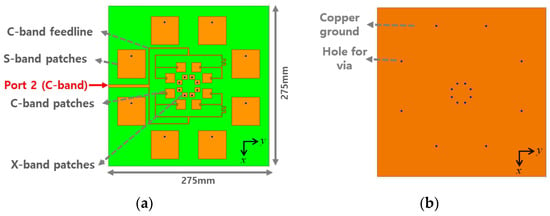

Figure 1.
Configuration of the three-layered proposed antenna: (a) three array antennas on the top layer; (b) ground plane between the top and bottom layers; (c) feed lines on the bottom layer.
3. Results
For the purpose of the evaluation, the proposed antenna design was evaluated using a full-wave simulation tool, HFSS. The simulated result was compared with the measured results. A photograph of the proposed array antenna is shown in Figure 2. Two substrates of Taconic TLY-5 were used for the fabricated antenna design. Two substrates were firmly attached using plastic screws. A comparison between simulated and measured reflection coefficients is shown in Figure 3. The three types of the radial array antennas provided impedance matching of less than −20 dB at the different frequency bands, which were reasonably good matching characteristics. It was observed that the resonant frequency of the measurement deviated from that of the simulation by 2.2% (C-band) and 1.4% (X-band), whereas an excellent agreement between the simulation and the measurement was observed for the S-band array antenna. The shift of the resonant frequencies (C-band) might be attributed to the connector effect, which is not included in the simulated results, although it affects the measured results. It is worth of noting that the reflection coefficient of one port was measured while the other two ports were terminated. Simulated and measured mutual couplings between two ports are presented in Figure 4. Excellent isolation below −40 dB was obtained throughout the frequency bands of interest. This might be attributed to the orthogonal antenna polarizations of two neighboring array antennas, as previously reported in [17]. The radiation patterns at the frequencies of 2 GHz, 5.8 GHz, and 10.525 GHz were measured inside a far-field anechoic chamber. The simulated and measured radiation patterns (co-pol) are shown in Figure 5. The far-field range of the anechoic chamber was enough to measure the proposed antenna at the far-field distance of the array antenna. The proposed antenna provides a simulated maximum gain of 14.7 dB, 15.7 dB, and 12.9 dB at each operating frequency band. The reasonably stable maximum gain was obtained owing to the identical number of element antennas that each array antenna possessed. The measured maximum gains were 14.3 dB, 15.3 dB, and 12.5 dB at each operating frequency band, which deviated from the simulation by less than 0.4 dB. It was observed that the cross-polarization level obtained from the full-wave simulation was below −41 dB in the S-band, below −23 dB in the C-band, and below −16 dB in the X-band in terms of each co-polarization level. The deviation between simulated and measured results was mainly caused by manufacturing tolerances, RF connectors, and manufacturing error of the 16 vias.
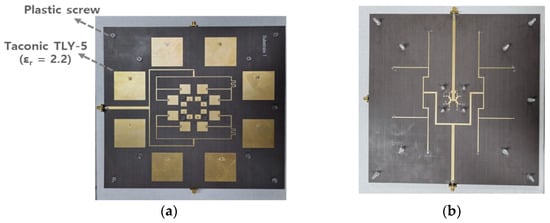
Figure 2.
Photographs of the fabricated antenna design: (a) top layer of the prototype antenna; (b) bottom layer of the prototype antenna.
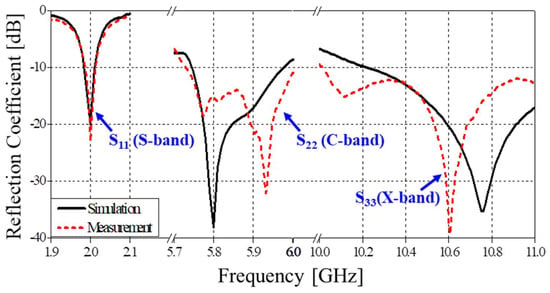
Figure 3.
Comparison of the reflection coefficients obtained from the HFSS simulations and measurements for port 1, port 2 and port 3.
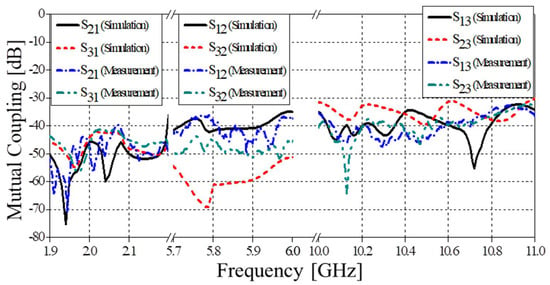
Figure 4.
Comparison of the mutual couplings obtained from the HFSS simulations and measurements among port 1, port 2 and port 3.
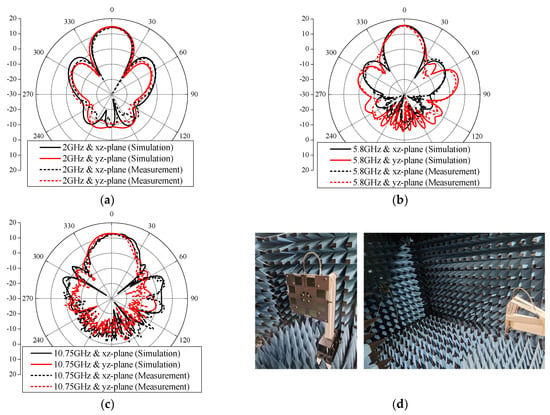
Figure 5.
Comparison of the simulated and the measured radiation patterns at the frequency of (a) 2 GHz, (b) 5.8 GHz, (c) 10.525 GHz, and (d) photograph of the measurement setup inside the far-field anechoic chamber.
4. Discussion
This paper presents a triple-band radial array antenna to implement a low-profile shared aperture antenna for radar applications. The use of the radial array antenna is advantageous to design an efficient layout for the different sets of array antennas. The feed network based on microstrip and coaxial feed was implemented on the top and bottom layer, which reduces the complexity of the feed network. The prototype was fabricated to validate the design of the proposed antenna. The reasonable matching characteristics were obtained at 2 GHz, 5.8 GHz, and 10.75 GHz, and the mutual coupling among the frequency bands was sufficiently reduced. The radiation patterns at the frequency bands were measured inside anechoic chamber, which exhibited the maximum gain of 12.5~15.3 dB for the frequency bands. This work primarily highlighted the aspects of achieving a multi-band array antenna. In future, comprehensive antenna designs, including electronic steering mechanisms, can be presented for creating diverse beam configurations at each frequency band. In addition, size reduction techniques such as fractal-shaped designs can be applied to the patch element design to reduce the entire size of the array antenna.
Author Contributions
Conceptualization, J.-H.L. and I.K.; methodology, I.K.; software, I.K.; validation, S.-G.L.; investigation, I.K.; resources, I.K.; data curation, I.K.; writing—original draft preparation, I.K. and S.-G.L.; writing—review and editing, S.-G.L.; visualization, I.K.; supervision, J.-H.L.; project administration, J.-H.L.; funding acquisition, J.-H.L. All authors have read and agreed to the published version of the manuscript.
Funding
Research of two of the authors, Sun-Gyu Lee and Jeong-Hae Lee, was supported by the Basic Science Research Program through the National Research Foundation of Korea (NRF), funded by the Ministry of Education (No. 2015R1A6A1A03031833).
Conflicts of Interest
The authors declare no conflict of interest.
References
- Moo, P.W.; Difilippo, D.J. Multifunction RF Systems for Naval Platform. Sensors 2018, 18, 2076. [Google Scholar] [CrossRef] [PubMed] [Green Version]
- Skolnik, M. Introduction to Radar Systems; McGRAW-HILL: New York, NY, USA, 2001. [Google Scholar]
- Kim, I.; Kim, H.; Lee, J.-H. Theoretical Minimum Detection Range for a Rapidly Moving Target and and Experimental Evaluation. J. Electromagn. Eng. Sci. 2021, 21, 161–164. [Google Scholar] [CrossRef]
- Li, K.; Dong, T.; Xia, Z. A Broadband Shared-Aperture L/S/X-Band Dual Polarized Antenna for SAR Applications. IEEE Access 2019, 7. [Google Scholar] [CrossRef]
- Pozar, D.M.; Targonski, S.D. A Shared-Aperture Dual-Band Dual-Polarized Microstrip Array. IEEE Trans. Antennas Propag. 2001, 49, 150–157. [Google Scholar] [CrossRef]
- Mao, C.-X.; Gao, S.; Wang, Y. Dual-Band Circularly Polarized Shared-Aperture Array for C-/X-Band Satellite Communication. IEEE Trans. Antennas Propag. 2017, 65, 5171–5178. [Google Scholar] [CrossRef]
- Jung, Y.-B.; Eom, S.-Y. A Compact MultiBand and Dual-Polarized Mobile Base-Station Antenna Using Optimal Array Structure. Int. J. Antennas Propag. 2015, 2015, 178245. [Google Scholar] [CrossRef]
- Kong, L.; Xu, X. A Compact Dual-Band Dual-Polarized Microstrip Antenna Array for MIMO-SAR Applications. IEEE Trans. Antennas Propag. 2018, 66, 2374–2381. [Google Scholar] [CrossRef]
- Kwon, G.; Park, J.; Kim, D.; Keum, C.H. Optimization of a Shared-Aperture Dual-Band Transmitting/Receiving Array Antenna for Radar Applications. IEEE Trans. Antennas Propag. 2017, 65, 7038–7051. [Google Scholar] [CrossRef]
- Coman, C.I.; Lager, I.E.; Lighart, L.P. A Deterministic Solution to the Problem of Interleaving Multiple Sparse Array Antennas. In Proceedings of the 2005 European Microwave Conference, Paris, France, 4–6 October 2005; pp. 4–11. [Google Scholar]
- Kwon, T.-S.; Lee, J.-G.; Lee, J.-H. Null Steering of Circular Array Using Array Factor for GPS Anti-Jam. J. Electromagn. Eng. Sci. 2018, 18, 267–269. [Google Scholar] [CrossRef] [Green Version]
- Boursianis, A.D.; Papadopoulou, M.S.; Pierezan, J.; Mariani, V.C.; Coelho, L.S.; Sarigiannidis, P.; Koulouridis, S.; Goudos, S.K. Multiband Patch Antenna Design Using Nature-Inspired Optimization Method. IEEE Open J. Antennas Propag. 2020, 2, 151–162. [Google Scholar] [CrossRef]
- Lalbakhsh, A.; Esselle, K.P. Directivity Improvement of a Fabry-Perot Cavity Antenna by Enhancing Near-field Characteristics. In Proceedings of the 2016 17th International Symposium on Antenna Technology and Applied Electromagnetics (ANTEM), Montreal, QC, Canada, 10–13 July 2016; pp. 1–2. [Google Scholar]
- Jamshidi, M.B.; Lalbakhsh, A.; Alibeigi, N.; Soheyli, M.R.; Oryani, B.; Rabbani, N. Socialization of Industrial Robots: An Innovative Solution To Improve Productivity. In Proceedings of the 2018 IEEE 9th Annual Information Technology, Electronics and Mobile Communication Conference (IEMCON), Vancouver, BC, Canada, 1–3 November 2018; pp. 832–837. [Google Scholar]
- Lalbakhsh, P.; Zaeri, B.; Lalbakhsh, A. An Improved Model of Ant Colony Optimization Using a Novel Pheromone Update Strategy. IEICE Trans. Inf. Syst. 2013, E96, 2309–2318. [Google Scholar] [CrossRef] [Green Version]
- Guo, Z.; Yang, G. Radial Uniform Circular Antenna Array for Dual-Mode OAM Communication. IEEE Antennas Wirel. Propag. Lett. 2017, 66, 404–407. [Google Scholar] [CrossRef]
- Kim, I.; Won Jung, C.; Kim, Y.; Eil Kim, Y. Low-profile Wideband MIMO Antenna with Suppressing Mutual Coupling between Two Antennas. Microw. Opt. Technol. Lett. 2008, 50, 1336–1339. [Google Scholar] [CrossRef]
Publisher’s Note: MDPI stays neutral with regard to jurisdictional claims in published maps and institutional affiliations. |
© 2021 by the authors. Licensee MDPI, Basel, Switzerland. This article is an open access article distributed under the terms and conditions of the Creative Commons Attribution (CC BY) license (https://creativecommons.org/licenses/by/4.0/).